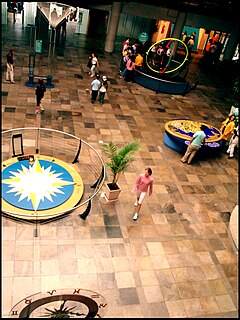Centro Universitário Franciscano is a private university center in Santa Maria, Rio Grande do Sul, Brazil. The center was founded in 1951 and today it offers over thirty undergraduate courses.

BR-153 is a major federal highway of Brazil, officially named the Transbrasiliana Highway. It also serves as part of the Belém-Brasília Highway in the stretch located between the cities of Wanderlândia, in the state of Tocantins, and Anápolis, in the state of Goiás.

Unisinos is a Brazilian private Jesuit university founded in 1969. Its main campus is located in Southern Brazil, in the city of São Leopoldo, state of Rio Grande do Sul. Unisinos has more than 30,000 students in its 91 undergraduate programs, 19 academic master's programs, 6 professional master's programs, and 14 PhD programs, with six schools – Polytechnic, Business, Law, Health, Creative Industry, and Humanities.

Traversodon is an extinct genus of cynodonts. It was a relative of the direct ancestor to modern mammals.

Paleontological Site Jazigo Cinco is located in the city of Santa Maria, Rio Grande do Sul, Brazil. And belongs to Santa Maria Formation. It is located in the neighborhood Kilometro 3 near Castelinho, is to 2.7 kilometers away from the Paleontological Site Arroio Cancela. It belongs to UFSM and is a center of research. It is the place where he was collecting the Staurikosaurus, the first Brazilian dinosaur. Site belongs to the region paleorrota.

Encruzilhada do Sul is a municipality in the state of Rio Grande do Sul, Brazil.

The Palaeontological Site Chiniquá is located in the Brazilian municipality of São Pedro do Sul, Rio Grande do Sul, along highway BR-287, about 70 kilometers west of the city of Santa Maria. The site occupies an area of about 250 hectares and is part of the geopark of paleorrota. It yielded fossils of Middle Triassic (Ladinian) age.

The PUCRS Museum of Science and Technology is a Brazilian museum run by the Pontifical Catholic University of Rio Grande do Sul (PUCRS), located in the city of Porto Alegre in Rio Grande do Sul, on Avenida Ipiranga 6681, Building 40, Parthenon in the neighborhood, near the PUCRS. The visiting hours are from Tuesdays to Sundays, from 9am to 5pm.

The Museum Daniel Cargnin is located at Rua do Comércio, 825 in the city of Mata, Rio Grande do Sul, Brazil. It received its name in honor of priest and paleontologist Daniel Cargnin, which collected more than 80 percent of fossils in the region of Mata.

Luangwa is an extinct genus of traversodontid cynodonts. The species Luangwa drysdalli was discovered 1963 in the valley of the Luangwa river in Zambia, Africa. Luangwa lived in the Triassic period 240 Million years ago.

The Sanga do Cabral Formation is a sedimentary rock formation found in Rio Grande do Sul, Brazil.
Minicynodon is an extinct genus of carnivorous brasilodontid cynodonts from the Late Triassic period. It lived during the late Triassic period in what is now Faxinal do Soturno, Rio Grande do Sul, southern Brazil. It is known from the holotype UFRGS PV 1030 T, a partial skull, recovered from the middle section of the Caturrita Formation, in paleorrota geopark. Minicynodon was named by José Fernando Bonaparte, César Leandro Schultz, Marina Bento Soares and Agustín G. Martinelli in 2010 and the type species is Minicynodon maieri.
Gomphodontosuchus is an extinct genus of cynodonts. It was created to describe the species Gomphodontosuchus brasiliensis.
Mario Costa Barberena was a Brazilian paleontologist.

The Museu de Ciências Naturais da Fundação Zoobotânica do Rio Grande do Sul, is a Brazilian museum located inside the Porto Alegre Botanical Garden. Open from Monday to Sunday 9am to 12pm and from 13h30 to 17h.
The genus Phyllotheca was created in 1828, when Brongniart described the type species Phyllotheca australis coming from Hawkesbury River, Australia.
Samaropsis is a form genus named by Goeppert in 1864. Later Sewart (1917) redefined the taxon to refer only to the seeds.
Buriadia is a genus that existed from the Carboniferous to the Permian. Vascular plants that are reproduced by seed and the type species had only Buriadia heterophylla. Put the name of Buriadiaceae family.
Leiosphaeridia is an extinct genus of algae or acritarchs. The genus of undefined species were found in outcrop Morro do Papaléo in the town of Mariana Pimentel in Brazil, the geopark Paleorrota. The outcrop date Sakmarian in Permian.
Quadrisporites is an extinct genus of acritarchs. The species Q. horridus was located in outcrop Morro do Papaléo in the town of Mariana Pimentel in Brazil, the geopark Paleorrota. The outcrop is in the Rio Bonito Formation and date of Sakmarian in the Permian.












